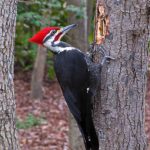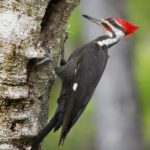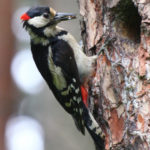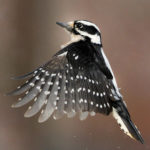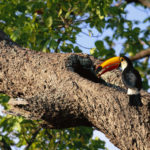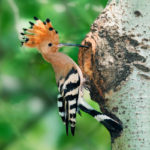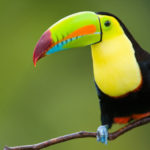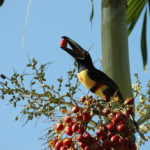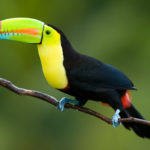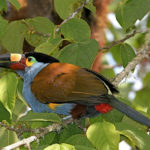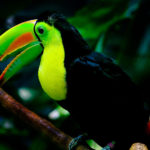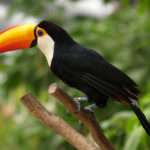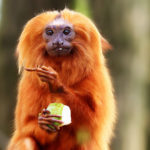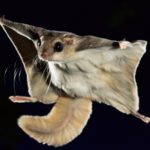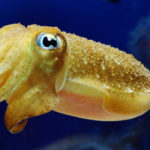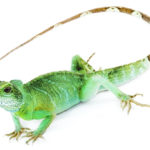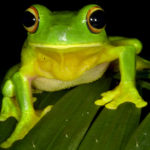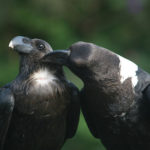Woodpeckers
 Woodpeckers are a large group of birds known for their unique ability to chisel trees. All of them belong to the same family of woodpeckers, to which the vertices also belong. In addition, the relatives of woodpeckers are bearded, medouchechchiki and toucans. In the world there are over 200 species of woodpeckers.
Woodpeckers are a large group of birds known for their unique ability to chisel trees. All of them belong to the same family of woodpeckers, to which the vertices also belong. In addition, the relatives of woodpeckers are bearded, medouchechchiki and toucans. In the world there are over 200 species of woodpeckers.
On average, body length in most species is 25 cm, and weight is 100 g, but there are exceptions to this rule. So, the largest species – the American royal woodpecker – had a length of almost 60 cm and weighed 600 g. Now this species is considered extinct and the role of the largest passed to a large Müller woodpecker with a length of 50 cm and a mass of 500 g. The smallest species, the golden-haired giraffe, The size is close to the hummingbird, its length is only 8 cm, and the weight is 7 g! The body of the woodpeckers seems elongated due to the tail of medium length and the head that continues the body line. Beak of woodpeckers chisel-shaped, sharp and durable.
The nostril is protected inside by bristles that prevent the chips from entering the respiratory tract during the chiselling of the tree. The skull of woodpeckers has a porous structure that protects the brain of these birds from concussion. The wings of woodpeckers are medium-sized and sharp, which allows them to easily maneuver between trees. Paws short, four-fingered, with two fingers pointing forward, and two – backwards (exception – three-toed woodpecker). This structure of the paws allows the birds to rest on vertical surfaces and to move along them.
The feather of the woodpeckers is stiff, close to the body, especially the stiff and springy rods of the feathers of the tail. Woodpeckers are painted very differently, in most cases the upper part of the body is monochromatic black or mottled with a chess black-and-white pattern, the lower part is lighter (white, gray), there is a red cap on the head. But this general scheme can have a variety of options, some species can have extensive areas of golden, green, white. Sexual dimorphism manifests itself in brighter areas of plumage in males (podhvoste, cap, etc.), in females they are painted in the tone of the body.
Woodpeckers are cosmopolites, they are found all over the world, the only continent not inhabited by them is Antarctica. In any case, woodpeckers are associated with woody vegetation, so they live mainly in forests. They populate all types of forest plantations: taiga, mixed, broad-leaved, dry and moist tropical forests. But even in the absence of trees, woodpeckers can settle in plants that replace them, for example … in huge cacti. Finally, earthen and pampas woodpeckers do without altitude plants altogether, these species settle in deserts and steppes, overgrown with grass. Thus, woodpeckers populate all types of landscapes. Most of these birds are sedentary, but in the case of poor cones, taiga species can roam, and golden woodpeckers in the northern parts of the range are real migratory birds.
They live alone, in the nesting period they stay in pairs, only acorn woodpeckers live in packs. The voices of the woodpeckers are diverse, but most species do not like to scream, the drumbeat beat out by the beak serves as a means of communication for them. A fraction can have a different duration and even a tonality depending on which tree, wet or wet, a woodpecker is tapping. The fraction also serves to indicate the boundaries of the site, and to attract a partner, during the marriage period the fraction is distributed in the forest especially often. Some birds have learned to use metal shells for poles and cans for their needs. The sound of a metal object is especially sonorous, so woodpeckers use such finds willingly. When a woodpecker knocks on wood, the maximum frequency of blows can reach 6-7 per second.
The woodpeckers are flying well, their flight is fast, with frequent flaps of wings, but they only resort to it reluctantly. Woodpeckers prefer to flutter between trees and spend most of the time crawling along the trunks. The ability to lasagna in most species is well developed, woodpeckers can sit on horizontal branches, climb up the trunks up and down their heads, hang upside down on thin branches. Only woodpeckers living in open spaces, climb on trunks or do not know how, or do it badly, because they do not have a rigid tail that would serve as a support for them. On the trunk, woodpeckers move by short jumps, in case of danger they do not fly away, but first hide from the enemy from the back of the tree and furtively peek out because of it. Only if the predator has got close, the woodpecker is flying away.
